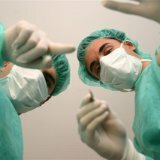Spasmolytics in abdominal surgery

The dramatic spastic contraction of smooth muscle has been known since ancient times and is reflected in everyday language."Colic", "fights" are words used by people far from medicine. So usually describe the specific pain caused by spasms of smooth muscles. However, in itself such a spasm is not only a pain, but also the beginning of many dangerous diseases. Physicians well know the vicious circle: a sharp spasm-tissue ischemia - edema - pain - the subsequent increase in spasm.
Clinical manifestations of smooth muscle cramps, familiar to every abdominal surgeon, are very diverse. The spasm of smooth muscles plays a special role in the formation of primary symptoms of cholecystitis, pancreatitis, acute and chronic cholangitis, as well as irritable bowel syndrome and postcholecystectomy sphincter dysfunctions. Only effective spasmolytic therapy in complex treatment can help to stop the acute process, giving the opportunity to make surgical intervention under the most favorable conditions.
The role of antispasmodics in
surgery In the post-operative period, antispasmodics are the most popular remedy, since any operational trauma causes reflex contraction of smooth muscle tissues. Spastic contractions of the intestines can also be of iatrogenic nature - they can occur, for example, during an overdosage of M-cholinolytics, with severe vegetative innervation disorders immediately after surgery.
For antispasmodic purposes, preparations of mainly 2 groups are used. These are anticholinergic drugs, as well as myotropic antispasmodics. Previously used M-holinoblokatory not found widespread medical use because of its lack of selectivity. The consequence of non-selective effects is a very large number of side effects. Among them, visual impairment, tachycardia, dry mouth, weakness and retention of urine. In addition, these drugs cause hypermotor dyskinesia and even hypotension of the sphincter apparatus of the stomach. That is why the views of clinicians are now turned to drugs that have direct myotropic effects.
The action of antispastic drugs of good quality
To the antispastic drugs at the present stage, the physicians demand the following: high efficiency, long-term effect, convenient technique of reception, no dangerous side effects. One of these drugs was Dyuspatalin or Mebeverin. Its mechanism is based on a blocking effect on sodium channels, preventing the influx of sodium into the cells and stopping the sequence of spasm-inducing events. One of the main advantages of drugs like Duspatalin, in contrast to other antispasmodics - is not only the relief of the spasm itself, but also the absence of risk of hypotonia of smooth muscles.
Given the harmonious combination of antispasmodic and prokinetic effects, modern antispasmodics( Drotaverin, Benzyclane, Bendazol, Duspatalin, etc.) are more suitable for prescribing during the postoperative period. It is then that a transient disturbance of vegetative innervation is observed, caused by an operating trauma, the action of anesthesia drugs, stress, etc. In this case, the patient has motor disorders of atonic and spastic types. Spasmolytics are also effective at later periods, when dysbiosis occurs after a preventive antibacterial therapy after surgery. It can only be quenched by means of a competent selection of probiotics. However, it takes time to completely restore the intestinal microflora. Spasmolytics in such cases act as a means of symptomatic therapy, which allows to relieve the patient of dyspeptic disorders: bloating and rumbling of the abdomen, spasmodic pain, and also through a decrease in motor activity, significantly reduce the frequency of stool. Thus, antispasmodics appear to be promising drugs for use in abdominal surgery. This is especially true in the late postoperative period, when it is possible to significantly improve the patient's quality of life to an acceptable level.



